
The Basics:
- For ages 8 and up (publisher suggests 9+)
- For 1 to 6 players
- Approximately 90 minutes to complete
Geek Skills:
- Active Listening & Communication
- Counting & Math
- Logical & Critical Decision Making
- Reading
- Pattern/Color Matching
- Strategy & Tactics
- Risk vs. Reward
- Cooperative & Team Play
- Hand/Resource Management
Learning Curve:
- Child – Easy
- Adult – Easy
Theme & Narrative:
- Join forces to survive an onslaught of monsters
Endorsements:
- Gamer Geek rejected!
- Parent Geek mixed!
- Child Geek mixed!
Overview
Legends are not born. Legends are forged in the fires of adversity, hardship, and victory. All the great heroes have overcome tremendous obstacles, risked total defeat, and triumphed in the end. You have lived your life in the shadow of such heroes and now you seek to create your own legend. Today you begin your journey that will either grant you eternal fame or a painful death.
Legends of Adventure, a self-published game designed by Zak Oberrath, is comprised of 1 Game board, 40 Hero cards, 70 Monster cards, 135 Treasure cards, 20 Adventure cards, 12 custom six-sided dice, 1 Divine Intervention die (another custom six-sided die), 4 Player Guide cards, and 2 Level markers. The component quality of the game ranges from average to excellent, from cards to board. The illustrations are all over the place, with some being simply spectacular and others being an obvious stretch reward that features the face of a backer or a friend. A nice touch, but it just looks weird and out-of-place at times. There were also some strange design choices. For example, the Hero and Monster cards have a lot of detail, but the Treasure cards only have icons and numbers. A few have the names of the Kickstarter campaign backers, as well. Again, a nice thought, but a bit jarring.
Preparing for Your Adventure
To set up the game, first place the game board in the middle of the playing area. On the game board is a Heroes Level and Monsters Level track. Place the blue Level marker on the “0” Heroes space and the red Level marker on the “0” Monsters space.
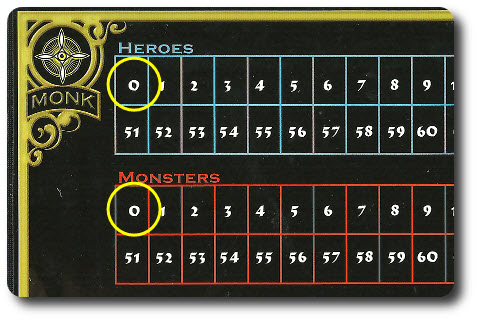
Second, separate each card by type. There will be 4 piles of cards when done. These will be Hero cards, Monster cards, Treasure cards, and Adventure cards. Shuffle each pile separately to create 4 decks of cards.
Third, deal 5 Hero cards to each player. Players should now look at their Hero cards and pick 3 to keep. Since Legends of Adventure is a cooperative game, players should feel free to discuss their choices in hopes of creating a well-rounded party of adventurers that will survive. Once each player has picked their 3 Hero cards, place all the other Hero cards back in the game box. Hand to each player a Player Guide card at this time if needed.
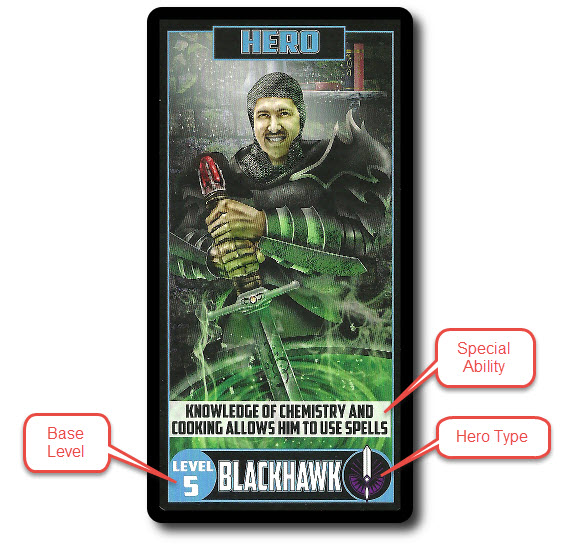
Fourth, deal 6 Treasure cards to each player. Players should look at their Treasure cards and then decide which of their 3 Hero cards they will play with first. Players will only have 3 Heroes during the game. When a Hero falls, it’s not replaced. The first Hero to be selected is normally the Hero that can use as many Treasure cards as possible, but the player is welcome to select any Hero they like. When they do, they place their selected Hero card in front of them, face-up, and the remaining 2 Hero cards face-down in their reserve. The Treasure cards go in the player’s hand.
Fifth, place the Adventure and Monster draw decks to one side of the game board. Decide who will be the first “Leader” and hand them the dice. It’s time to begin your adventure!
Heroes of Fate and Luck
Legends of Adventure is played in rounds and turns. A single round is also referred to as an “Adventure” or “Adventure round” and players will take multiple turns fighting monsters during the Adventure in hopes of completing it. A typical Adventure is summarized here.
Step 1: Begin the Adventure
Each new Adventure round will have a Leader. The Leader draws an Adventure card, reads it out loud, and then places it face-up on the lowest available number space on the game board. For example, the first Adventure card will be placed on the space noted with a “1”, the second on the “2”, and so on.
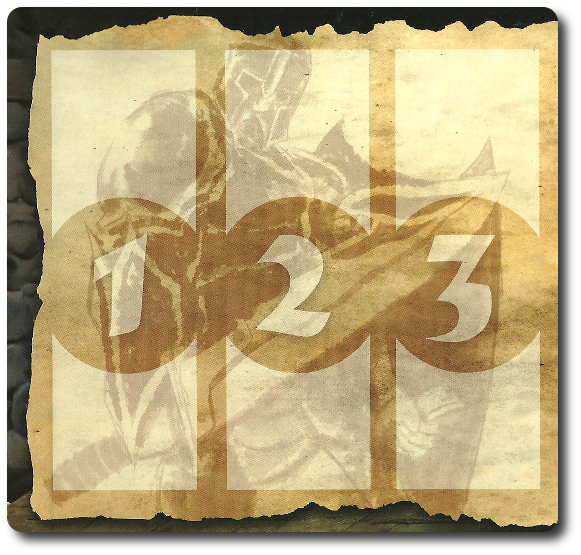
Adventure cards have a title and will list rule changes that will immediately take effect, impacting all players. Only the current Adventure card is used. Previously fought and beaten Adventure cards are no longer active.
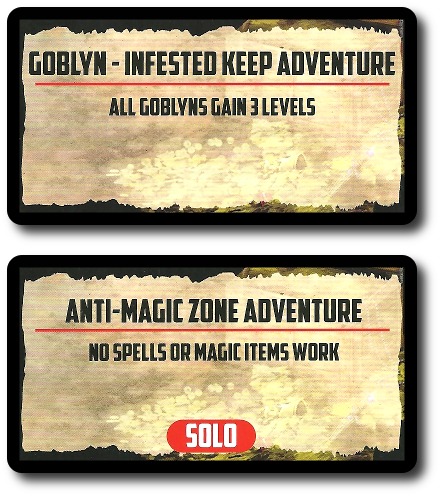
If an Adventure cards has the keyword “Solo” listed, then the Leader is the only player who can continue this Adventure round. The Leader’s companions might be able to assist, but this is a battle the Leader will more or less have to fight on their own.
Step 2: Reveal Monsters
The Leader now draws 1 Monster card per player in the game, revealing them one at a time and reading the Monster’s special ability. If the players need to immediately react, they do so, resolving the Monster card’s special ability before drawing another card. If the Adventure card effects a Monster card, it does so based on when it most makes sense.
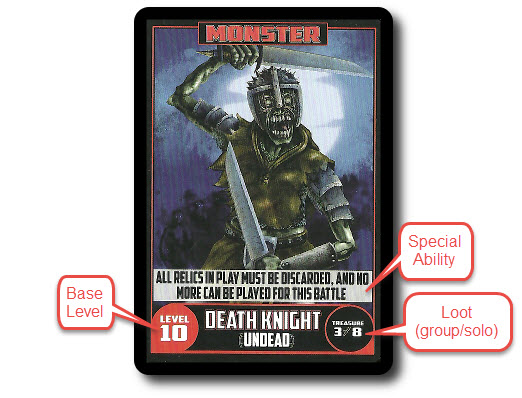
After all the Monster cards are revealed, the Leader adds the Base Level value of all Monster cards in play. The Level marker is then moved to that number on the Monsters Level track on the game board. This is the Monster’s base strength that the Heroes must now attempt to beat.
Step 3: Combat!
Starting with the Leader, each player now rolls a number of dice equal to their Hero card’s Base Level. For every “Water” (looks like a raindrop) rolled, the players move the Level marker on the Heroes Level track up by one. The end result will now show the starting Hero and Monster strength levels. From here, things could go several ways.
The “losing group” will be either the Heroes or the Monsters, depending on which of the two has the fewest strength levels on the Level track. Ties go to the Monster group.
In order to move the Level marker, both Heroes and Monsters play Treasure cards. By default, the Monster group will only be able to play 1 Treasure card per Monster card, unless the Adventure or Monster card says differently. In Addition, the Leader will only draw 1 Treasure card per Monster card when the Monster group is losing. Otherwise, no Treasure cards are drawn.

Just a few examples of the many Treasure cards available
Players start with Treasure cards they have. They will be given more, but only if they win the battle. There are several Treasure card types to select from and not all of them are available to the player, even if they have the card in their hand. Each Hero card type (Knight, Monk, Rogue, and Wizard) can use 3 Treasure card types. All Hero card types can use the “Divine Intervention” Treasure card.

Each Hero can use 3 different types of Treasure cards, as indicated by the above chart
The Treasure cards are broken down into the following types. Each type has an icon that corresponds to the above chart. The charts can also be found on the Player Guide cards.
- “Ally” Treasure cards represent foot-soldiers, hirelings, and friends that following the Hero around. They aid the Hero by adding dice that are rolled during the combat step of the game. They can only be used once, however, and must be discarded after the battle is over.
- “Spell” Treasure cards represent powerful magic that is both destructive and beneficial. When cast, the player is given a number of dice to throw, adding to the Heroes total strength level. Once cast, the spell is no more and the Treasure card is discarded.
- “Special Moves” Treasure cards represent a Hero’s skill in the Martial Arts. A simple fist becomes a mace and a kick becomes a war hammer. These unarmed attacks are potentially deadly, but after the attack is completed, hit or miss, the Treasure card is discarded.
- “Divine Intervention” Treasure cards call upon a Higher Power to intervene on the Heroes’ behalf. The gods are always benevolent, but their blessings are random. When played, the Divine Intervention die is rolled and the results are bestowed on the player. Possible outcomes include re-rolling dice, doubling the benefit of Treasure cards, drawing more Treasure cards, passing Treasure cards to a friend, or removing no longer necessary gear. Once the gods’ blessing rains down on the Hero, the Treasure card is discarded.
- “Magic Item” Treasure cards represent ancient items of power. These could be weapons, a ring, or a pendant. These treasures are worn by the Hero and continue to aid them in their adventure. No more than 3 Treasure cards can be attached to a Hero card at a time.
- “Relic” Treasure cards are greater forms of magical items. They can be attached to the Hero card and will continue to provide aid until removed or lost. A “Relic” does not provide a great deal of dice. Instead, it offers beneficial powers that can be matched with other Treasure cards.
Starting with the Leader, each player plays a Treasure card and rolls the dice. Sometimes the player will need to roll “Water” and other times the Treasure card will change which icon must be rolled. After each roll of the dice, the Level tracker is moved. When the Heroes Level tracker is at a higher value than the Monsters Level tracker, a new Treasure card is drawn and the dice are rolled.
If the Monsters Level tracker value is higher, the players must again play Treasure cards to move their level. If the Monsters Level track value is less than the Heroes Level track, the Heroes have won!
Step 4: Clean Up and End of Adventure
After the Heroes win the battle, the Leader collects the Monster cards and counts the number of Treasure cards the group earns. The Treasure cards can be divided up anyway the players like.
Players could lose the battle, but it’s not as easy as it sounds. Players must continue to play Treasure cards until they defeat the Monster cards. If a player ever runs out of Treasure cards, their Hero “dies” and a Hero card in their reserve is immediately brought into play. The player then rolls a number of dice equal to their Hero’s Base Level. If a player loses all 3 of their Heroes, they are out of the game.
The game now continues with the role of “Leader” being passed to the next player in turn order sequence.
The End of the Adventure
The players win if they complete 10 Adventure rounds. If all the players lose their Heroes, then they have lost the game and their chance to become legend.
Game Variants
A few game variants are provided for players to try if they want to subtly change how the game is played.
Easier Adventurers
If players are finding the game too difficult, remove all Monster cards that are Base Level 10 before playing. If the game is still too difficult, remove the next highest Base Level value.
Epic Battles
Find all the Base Level 10 Monster cards, shuffle, and randomly draw 1 to take part in the battle during the 10th and final Adventure round. Shuffle the remaining Monster cards back in the deck. Players are now guaranteed to have a tough battle on their hands when they go on their last adventure.
Last Hero Standing
It’s very difficult to continue the adventure when a fellow player loses their 3rd and final Hero card. Many groups opt to end the game right then and there, but for those who hate giving up, you can continue playing until the bitter end. Normally, when a player loses their last Hero, they are still counted when adding Monster cards, despite not contributing to the party. This game variant changes that, directing the players to only draw 1 Monster card per active player in the game. Now the odds of survival are a little bit better, but not nearly enough in the player’s favor to make the game a walk in the park.
To learn more about Legends of Adventure, visit the game’s website.
Final Word
The Child Geeks were excited by the idea of working together on a great adventure. To some of the older Child Geeks, Legends of Adventure sounded like a Role-Playing game. According to one older Child Geek, “The description of the game makes it sound like we are an adventuring party. I really hope it’s like that’.” The younger Child Geeks just liked the idea of playing with their older siblings as a team versus competing against them. After we taught the game and began the adventure, the mood around the table was mixed. Depending on how lucky the Child Geeks were and what Monster cards were drawn, the Child Geeks were ecstatic or exceedingly bitter. According to one of the excited Child Geeks, “This game rocks! Each battle feels really epic!” And according to one of the bitter Child Geeks, “This game is impossible! We can’t get the cards we need and we are always behind!” In the end, the Child Geeks both loved and hated Legends of Adventure. It all came down to how lucky they were.
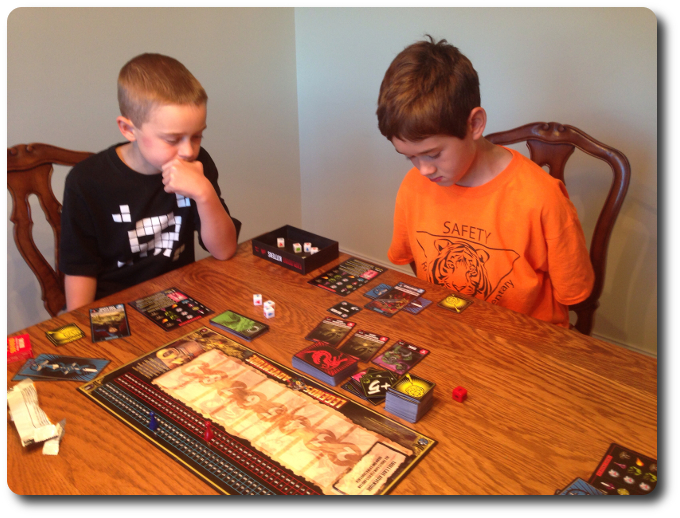
My two fellow adventurers consider the challenge before them
The Parent Geeks were less impressed with the game, finding it to be mostly about numbers, having very little to do with adventure, and being heavily luck based. Which is not to say that some of them didn’t have fun. According to one Parent Geek who did, “This is a challenging and punishing game. You really have to work together and be as cooperative as possible if you want to win.” A Parent Geek who was not so impressed said, “It’s all about what dice you roll and what cards you have. There’s a lot of luck involved, which never really made me feel epic. Just lucky.” The Parent Geeks did enjoy playing the game with their family, but found that the game was not really that friendly towards them. Among their peers, the Parent Geeks felt that Legends of Adventure was a game that required the players to be really good at communicating and strategizing. Even then, they found the game to be very punishing. When the votes came in, about half of the Parent Geeks believed that Legends of Adventure wasn’t a bad game, but it was most certainly a very difficult one. The other half of the Parent Geeks found the game’s level of difficulty to be too much, resulting in a less than fun game playing experience.
The Gamer Geeks were excited to try the game based on its description, but were quickly disappointed with it. According to one Gamer Geek, “This entire thing is one big luck fest. No strategy. No tactics. Just roll dice, play a card, do some math, and hope the numbers add up.” Another Gamer Geek said, “Way too clunky. I like the ideas the designer has, but they aren’t translating to create good game play. I’m just not engaged.” None of the Gamer Geeks found the game to be difficult, but they all believed the game outcomes depended so greatly on luck and randomness that the game itself wasn’t worth being played. The final count of the votes showed that the Gamer Geeks had no love for Legends of Adventure.
The rules for this game are hurting. They are both ambiguous and incomplete in some cases. New players to the game will immediately feel like they need to search for an FAQ or find the missing instructions. One area that many of our players remarked on was the game’s difficulty, finding it impossible at times. This is by design, as luck would have it. Or better put, bad luck. A great deal rides on the roll of the dice that could make or break a player’s attempt to conquer their foes. There is also the luck of the card draw that could give the player exactly what they need or left holding a handful of cards they cannot use. This means there will be games when players are stuck and have to pay the price through no fault of their own. That can be and is very frustrating.
I like many aspects of this game, but it just doesn’t come together well enough to create a cohesive experience that I would consider enjoyable. I firmly believe that all the game needs to elevate itself is better rules and crisper game play, as cooperative aspect of the game and the way players march through their Adventures is well done. I rather enjoyed the fact that every game I played or taught was different than the last one, truly giving players a unique experience each and every time. Unfortunately, it was common to be confused by rules, wondering what we should do next, and feeling cheated when the game wouldn’t allow us a chance to win.
But such is an adventurer’s life, I suppose. Nowhere is it written down that good guys always win and monsters must always lose. Lady Luck is a fickle mistress and she neither loves nor hates the players in the game, but the dice most certainly have a grudge. Treasure cards are the only thing between success and failure, where the battle is won not by skill, but by luck. If such a game sounds like it would be fun for you and yours, I encourage you to give it a try. For everyone else, you’ll be hard-pressed to find an adventure here.
This game was given to Father Geek as a review copy. Father Geek was not paid, bribed, wined, dined, or threatened in vain hopes of influencing this review. Such is the statuesque and legendary integrity of Father Geek.



